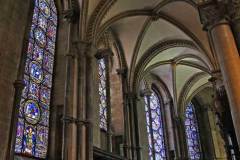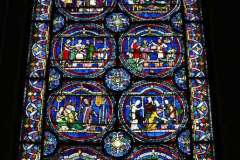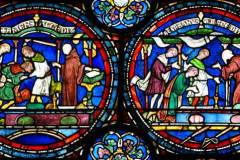There were originally 12 Miracle windows, six on the north side and six on the south side of the shrine of St Thomas in the centre of the Trinity chapel (Image 1). All the windows were complete by the time the Translation of St Thomas’ remains from the crypt to the Trinity chapel on 7th July 1220. As in the south windows, there are scenes portraying miracles that were seen to have occurred as a result of prayer to, or the intervention of, St Thomas.
The most westerly one is rather different from the other Miracle windows and is therefore described under ‘Life of Becket’. The next window is a 19th century replacement and the third is original but has been truncated in the 15th century to allow the construction of the chantry chapel below; the remaining three windows are all original early 13th century glass (Image 2).
There are many scenes portrayed in these four original windows and they can be explained by comparing the accounts recorded by the monks of the stories told by pilgrims who came to the tomb in the crypt in the late 13th century. It is therefore possible to identify some of the characters in the windows such as their names, where they came from, their ailments or conditions and how these were changed by prayers to or intercessions of St Thomas; some scenes are explained with Latin inscriptions.
What to see:
Selecting just one story in window number 4 (Image 3), from the left, second row up, left roundel:
- In this first scene, ‘mad’ Henry from the village of Fordwich, a nearby village, is being dragged and beaten by his two ‘carers’ to St Thomas’ tomb with his hands tied behind his back and being beaten with sticks. There is clearly a lot of action as Henry’s cloak has fallen in front of him, one ‘carer’ has his cloak caught up on a candlestick on the tomb and the priest who is looking on is apprehensive and worried that his lectern is about to be knocked over in the melee.
- In the right hand roundel Henry who has been persuaded to pray at the tomb overnight has become calm as shown by his cloak is now behind him; the onlookers are either clapping for joy at his recovery, expressing amazement or in the case of the priest slapping his forehead in astonishment. The rope that bound Henry and the sticks are left as a ‘ex voto’, a thanks offering.
AT



